Railway Freight Operations
- Explosives, Chemicals & Gasses
Explosives, toxic gasses and inflammable materials are all classed
as 'dangerous goods' by the railways. They were not allowed to turn this
traffic down because of the common carriers legislation (see Historical
Background section for details of this legislation) but they had to take
sensible precautions when moving such goods on the system. Sometimes the
precautions to be taken were only arrived at following an unpleasant accident,
but that is common to all industries.
The common carriers legislation
allowed the railways to refuse to carry certain goods in their own vehicles.
These included corrosive chemicals or materials which might contaminate other
cargo. As a result a lot of the more dangerous goods were transported in
privately owned vehicles. There is a separate section on PO wagon operations
but the dangerous goods variety are discussed in this section.
By the
mid 1980's BR was shifting only about 10 percent of the chemicals being moved
in the UK and the nature of the traffic meant that wagon load traffic was the
norm. The end of Speedlink air-braked wagon load service in 1991 brought an
abrupt end to much of this traffic and recovery has been a slow business
(several firms allowed their rail connection to fall into disuse and
reinstating the link would be an expensive business). Some chemicals are
carried as train-load traffic, either because of the quantity being moved or
because the chemicals involved are too dangerous to be mixed with other
traffic. An example of this latter category is the hydrocyanic acid gas tanks
operated in the North East by ICI (discussed below).
Barrier Wagons
and Reach Wagons
Gunpowder vans, oil tanks and other vehicles
containing flammable or hazardous materials were marshalled with wagons
containing non flammable materials to either side or, if this was not possible,
a `barrier wagon' was inserted for the purpose.
A barrier wagon is
simply an empty wagon placed to separate the dangerous cargo from other wagons
in the rake. Where the entire rake was comprised of vehicles carrying dangerous
goods barrier vehicles are required between the wagons and the brake van and at
the other end between the wagons and the loco. Sometimes the barrier wagons are
designated items of stock reserved for this purpose, redundant cross channel
ferry vans and open wagons such as the Peco 8 plank tarpaulin wagon have been
used for this work since the 1970's and a number of air braked VCA vans were
allocated to barrier duties in the 1980's. Some surprisingly elderly vehicles
have been retained for barrier work, in the early 1980's former British
Railways plate and trestle wagons (the latter still carrying their wooden
trestles) were used as barriers on chemical tank trains in the North East. If a
reserved `barrier wagon' was not available a `spare' wagon or van of some kind
could be used although this did have the disadvantage that it was more likely
to be accidentally separated from the dangerous goods wagon en route during
marshalling.
Only recently, in the early 1980's, have British Railways produced
purpose-built barrier wagons, these have raised steel ends mounted on a
standard air braked chassis and are only used (as far as I am aware) with
tankers carrying particularly dangerous chemicals.
Fig ___ Purpose
built air-braked barrier wagons
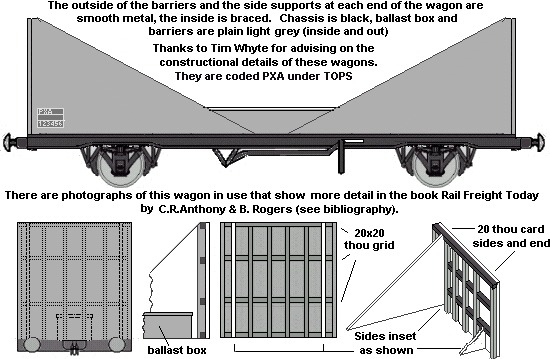
Oil trains of Class A or B all had barrier wagons attached, on a BR era steam train three or four empty mineral wagons (often the fitted type) would be typical at the engine end, at the brake van end one or two minerals might be used. I have seen several photos showing early BR era mixed pick-up goods trains where the oil tanks were positioned toward the rear of the train, separated from the beake van by perhaps a single (loaded or unloaded) mineral wagon. The requirement for barrier wagons on oil trains was withdrawn in (I believe) 1962 but I have not (yet) seen a photo showing a steam engine hauled oil train without the barrier wagons.
In
some cases British Railways stipulated that a van be used as the barrier
vehicle, this rule seems to have applied to wagons carrying anything which
might explode but I have not been able to confirm the details. Given the tall
ends of the purpose built barrier wagons I would assume these would cover that
requirement.
By the later 1970s the requirement for explosives was that the barrier had to be a minumim of two 'SLU', SLU stands for Standard Length Unit, 21 feet or 7 yards, a measure used to establish train length and capacity of loops and sidings. I am not sure when this measure was addopted however one SLU is about the length of a twelve foot wheelbase wagon or van.
Where wagons had to be positioned in a dangerous area, for
example LPG tanks being pushed into a terminal, the locomotive was not allowed
to cross the threshold because of the danger of fire. To get round this problem
a 'reach wagon' is provided, basically any fairly long wheelbase redundant
wagon or van. The bodywork is usually removed from these wagons but the floor
may well be left in place. Cutting away the sides of the Peco plate wagon down
to floor level and scribing in the ends of the floor planks makes a fairly
typical and prototypically accurate reach wagon. The Peco 'tarpaulin wagon' was
also used as a reach wagon, although I have not seen any photographs so I do
not know if the sides and-or the ends were removed. For both these wagons you
should ideally modify the Peco chassis, this is not difficult and is discussed
in more detail in the section on Kit Bashing.
Where a dedicated reach wagon was not left on-site it was common practice, certainly by the later 1970s, for a brake van to be taken along to perform this duty (although Richard, a former goods guard, noted that 'lighting the stove was frowned upon!' - See also Railway Freight Operations - Train Formations for more on the use of brake vans)
Gunpowder vans
From the early days of the railways explosives were moved in purpose
built, metal bodied, wood lined vans called 'gunpowder vans'. Open wagons are
never used for this traffic, for fairly obvious reasons. The RCH rules covered
the design of these vans, which were always clearly marked and often
distinguished by body colour (the Midland Railway painted them bright red).
Nineteenth century vans were often of unusual design, some featured
semi-circular roofs and some had doors on only one side. The narrow gauge
gunpowder van shown in the section on Track - Narrow Gauge Track and Stock is
essentially a scaled down variant of a type used by the Midland Railway amongst
others. By the 1920's everyone had adopted a broadly similar design similar to
the GWR 'iron mink' goods van lined with wood. There was still some variation
in the appearance however, sketches of different company designs will be found
in the sections dealing with livery. The N Gauge Society offer a kit of a GWR
Iron Mink with alternative doors for making the gunpowder van version.
Gunpowder van retained wooden brake blocks for many years (I believe they had
changed over to iron by the 1930's) and a standard RCH requirement on all such
vans was a rectangular metal plate mounted on the door bearing a set of
standard instructions regarding the use of 'nailess over boots' (to avoid
sparks) and not running the van through a goods shed.
In peace time a
maximum of 5 gunpowder vans could be included in a single train. In wartime
entire trains might be made up of gunpowder vans with some open wagons also
pressed into service, up to sixty vehicles might form such a train. There was a
general prohibition on shunting gunpowder vans into goods sheds, when loading
or unloading on railway property this would have been done well away from
everything else in the yard.
In the 1950's BR built a number of
gunpowder vans to the basic pre-war, RCH approved, design. They look very like
the type used by the LNER although the BR wagons had a ten foot wheelbase
rather than the traditional nine foot. The BR built vans remained in use up to
the early 1980's and I understand that redundant ferry vans (presumably the
smaller ten foot wheelbase types) were marshalled to either side to act as
barrier vehicles (the large ferry vans could not have their air brake connected with these older gunpowder wagons in the rake). I have also seen reference to the use of redundant ferry open
wagons (similar to the Peco fifteen foot wheelbase 'tarpaulin wagons') being
used as barrier wagons but these were
not normally used with vans carrying explosives as the rules required vans.
Fig___ BR standard
gunpowder van (vacuum brake fitted)
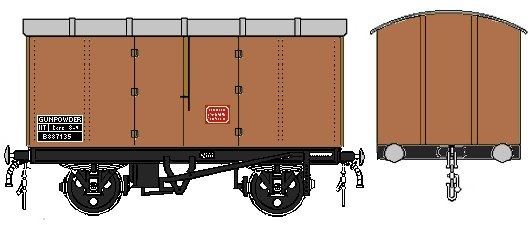
The BR
van can be made from a Peco 'ventilated van' (the one with the vertically
planked sides) by sanding the sides and ends smooth, scribing in the doors and
adding detail from plastic card and rod. No special air braked explosives
vehicles were built but in the 1980's gunpowder and other explosives were
shipped in standard VDA vans, with a `barrier wagon' (an empty air-braked van)
to either side.
Acids and other corrosive chemicals
There were a number of private owner tanker wagons built for the carriage of acids,
their construction is discussed in the Goods Rolling Stock Design - Rail Tanks
section and example liveries may also be found in the Livery - Tank Wagons
section. As their contents were not liable to catch fire, explode or give off
dangerous fumes they were shipped as wagon load traffic in conventional goods
trains, without barrier wagons, and as far as I am aware there were no special
rules regarding their placement in the rake.
A lot of acid eats metal so
from the early nineteenth century until about the time of the Second World War
a lot of acid was shipped in large 'Ali Baba' shaped earthenware jars. I am
still trying to establish when these fell from use. There were even some
tank wagons built specifically to carry these jars, they resembled eight plank
coal wagons but without any doors.
My sketch is based on a photograph (I
believe it was in a book on the wagons of the Gloucester Railway Wagon and
Coach Co.) but may be inaccurate in detail, it is based on a quick sketch and
some notes in my notebook. I am still trying to establish if they used straw to
pack the jars in place or if they used rubber cushions. I believe the livery
was all over black with white markings and a white patch with red lettering on
the lower side as shown.
Fig___ Wagon for carrying earthenware acid
tanks
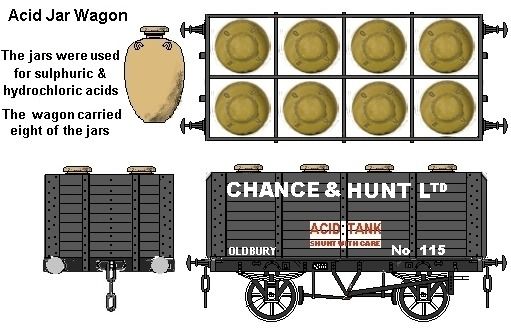
This wagon was in
use during the First World War, when Chance and Hunt built a large TNT works
(TNT uses sulphuric and nitric acids in its manufacture) but I would doubt that
this type of wagon remained in service beyond the 1920's on the main lines.
They may well have lasted into the 1960's on a private industrial line however
as I believe the earthenware 'Ali Baba' jars were still in use at that time.
Modelling these wagons is discussed in the section on Kit Bashing. A wooden
bodied PO tank for carrying ferric chloride has been illustrated in the section
on Rolling Stock Design - Tank Wagons.
Chance and Hunt was formed by the
merger in 1898 of Chance Brothers (who owned the Oldbury works) and Wm. Hunt
and Sons of Wednesbury. Chance Bros was a glass making firm, best known for
their work on lighthouse lenses, The Oldbury works had been set up to make salt
cake. In 1890 this works, the largest in the Midlands, was set up as an
independent concern trading as The Oldbury Alkali Company Limited). In 1926 ICI
was formed and although Chance and Hunt remained in occasional use as a brand
the Ltd was dropped. In April 1999, Chance & Hunt once again became Chance
& Hunt Limited, following a management buy-out from ICI but rail traffic
had ceased in about 1995 (in the later years the only traffic was chlorine
tanks). The internal rail system at Oldbury was sufficiently large to warrant
the firm operating their own 0-4-0 shunting engines.
The acid jar shown below is a typical 200 gallon type, standing about five feet high this example is preserved at 'Catalyst' the museum of Chemical Industry (Mersey Road,Widnes,Cheshire, WA8 0DF). This jar was made by Hathern Station Brick & Terra Cotta Company (the jar is marked Hathernware), a tera cotta brick manufacturer which turned it attention to acid proof vessels when World War One broke out and supplies of German vessels were no longer available. It took almost a year to develop the acid resistant clay bodies necessary and, utilising the same manufacturing skills employed in the production of terra cotta, 'Hathernware' Industrial Ceramics was started (now I believe part of Naylor Hathernware, the brick making side of the business being part of Ibstock Hathernware Limited).
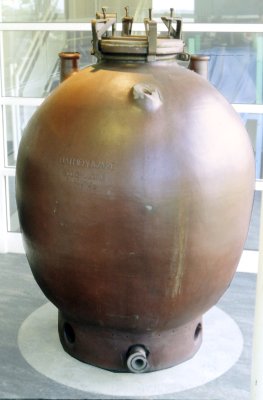
Sulphuric acid is
used in considerable quantities in a number of industries and in the early BR
era (and possibly before) 'demountable tanks' were often used to carry the
stuff. These were often referred to as Vitroil tanks and a kit of a BR built
ten ton capacity tank with its associated wagon is available from
Fleetline.
Fig___ Vitriol Tank

The markings I have in my
notebook (noted from a photograph of such as wagon) indicate BR ownership of
the wagon, the tank could be either red or black or it might carry the livery
of the leasing company. The example shown was black (tank and chassis) but had
a red board mounted on the side carrying the electrification flashes and the
cargo details. To add the board I would suggest producing it twice full size or
larger on a computer ink jet printer then having it reduced to the right size
on a colour photo-copier. A home colour printer does not have a sufficiently
high resolution to produce good quality 1mm lettering, the photocopier does.
The 80gsm paper these machines use is about an inch think in N so I would not
mount this on a plastic card strip. Example liveries for other demountable
chemical tanks are included in the section on Livery - Tank Wagons. From the
1970's the 'hazchem' symbol was required on all vehicles carrying dangerous
cargo. The Hazchem markings are discussed in detail under Livery - Tank
Wagons.
These demountable tanks might be dispatched as a block load
from the factory producing the contents but end users might only require a
single tank, which would travel as a single wagon load either to their works
siding or to the local goods yard to be sent on by road lorry.
For some strange reason, given the risks involved, the railway companies were prepared
to carry corrosive liquids in glass bottles in their own wagons and vans. I
have seen a photograph (dating from about 1920) of a two plank open wagon with
a full load of carboys of sulphuric acid. The eighteen inch diameter spherical
bottles were carried in circular straw-filled wicker baskets and arranged in
rows on the floor of the wagon. In the photograph there was no tarpaulin
covering the load and this may be the way it travelled given the likelihood of
the sheet being damaged by this cargo.
Compressed Gasses
The railways carried iron or steel cylinders of compressed gasses certainly from the 1860s and probably before that date. As far as I can determine these were carried mixed in with other goods and no special rolling stock was involved. By the later nineteenth century industry required gasses in industrial quantities and some pressure tank wagons were in service (not least for supplying coal gas to outlying stations on the railway network), however as far as I can tell the shipment of most other compressed gasses in railway tank wagons seems to date from about the 1930s.
Coal Gas
Coal gas was regularly shipped by rail but only, as far as I am
aware, for use by the railway company itself, not for sale or on behalf of
third parties. The gas was shipped in a range of tank wagons, often on retired
four wheeled coach chassis, and I believe it travelled in ordinary goods trains
to where it was required. It was then parked in a siding and used to recharge
the gas cylinders on coaches, used for both lighting and (in kitchen coaches)
cooking. A small number of goods vans, usually the high speed fruit vans and
the line, were equipped with gas lights and these would also have required the
occasional top-up. The design of these gas tank wagons is covered in the Goods
Rolling Stock Design - Departmental Stock section.
Oxy-acetylene welding was invented in 1900 by Frenchman Edmund Fouche,
this used cylinders of oxygen and acetylene and it was the development of the
cylinders which made it practicable (see also Vol 2 - Chemicals). Another
application for oxy-acetylene is cutting and this technique appeared soon after
the welding kits. Acetylene gas is extremely unstable, the cylinders used to
contain it have to be filled with another material to make it safe to store and
transport. Oxygen is also extremely dangerous however as far as I am aware
these gasses were transported in the familiar five foot long by one foot wide
cylinders in standard vans. They would be treated as dangerous cargo and would
require barrier wagons as described above. Oxygen, being effectively explosive,
would require a barrier van.
Chlorine
Liquid chlorine gas was certainly being shipped in privately owned 14
ton (capacity) rail tank wagons by the mid 1930's and possibly before. By the
later 1930's bogie tank wagons were in use for this cargo. The hutched tank
wagons described in 'Goods Rolling Stock Design - Rail Tanks' section were
also used for this traffic, although the purpose of the external wooden body is
unclear. Both ICI (Runcorn) and Castner Kellner Alkali (Runcorn) had tanks of
this type, when used for this traffic they would be marked Liquid Chlorine on
the lower sides.
In the 1940s ICI introduced a fleet of chlorine tanks on 10'6" wheelbase chassis and later they converted some 12' wheelbase acid tanks for this traffic.
Modelling the ICI chlorine tank wagons built in 1943 is discussed in the section on Kit Bashing.
The ICI tanks (and similar tanks operated by Murgatroyds) left the production plant in Cheshire as a block train but smaller users might receive only one or two tanks. Tanks carrying gasses or liquids producing dangerous vapour were originally painted white with a six in red band round the tank at each end, this changed in the later 1960s to a single horizontal orange stripe around the middle of the tank.
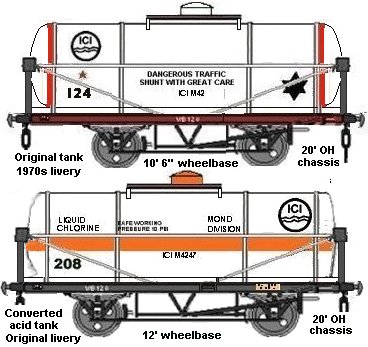
Given the lethal nature of this gas the use of a
barrier wagon between the tank and the guards van, or between the tank and the
locomotive, would seem to be essential. I have not been able to verify the
rules however, if anyone can cast any light on this I would appreciate hearing
from you.
Liquid Petroleum Gas (LPG)
LPG (Liquid Petroleum
Gas; Butane & Propane principally) has been moved in bulk by rail since the
1950's, British Railways actually built a small fleet of twelve foot wheelbase
20 ton compressed gas tanks to dia 1/306 in 1952 for propane and butane traffic from Fawley refinery. These were
classed as Class A tanks that at the time were still not allowed to have bottom
discharge so they had a filling dome on the top with ladders to either side.
The tank was lagged, twenty one feet long by seven feet in diameter and carried
on a wooden frame with traditional braced end frames. These were leased to a tank rental company but I do not know who and I have not been able to confirm the livery.
The Parkside Dundas twelve
foot wheelbase chassis would serve for a model and the body can be made using
external plastic conduit, available in 15mm diameter but this need superglue to fix it to the chassis and fix things to it. Alternatively,
if you are considering making the bogie tank wagon using the Peco tank kit (see
Fig ___), the tank ends and end supports from the Peco tank could be used with
a length of suitable tube.
These were British Railways tanks, both
chassis and barrel, so the livery would be a dove grey or white tank with 6 inch wide red vertical bands at each end and a red solebar, changing in the later 1960s or early 70s to a horizontal
orange stripe (indicating a compressed gas load) round the centre-line and fast
traffic stars in black. The chassis would be black with the solebars painted
red. I have not so far been able to confirm the lettering details used on these
tanks.
In 1962 Shell BP introduced the first big vacuum braked LPG tanks, similar in outline to the Peco LPG tank (which is currently available only in 1970s Mobil livery with the horizontal orange band), in the later 1960s these Shell BP tanks were used by other firms (the only change being the removal of the Shell and BP logos from the tank sides).
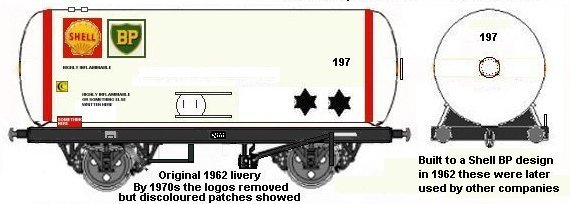
LPG is shipped in as a liquid in pressurised tanks with loading/discharge valves usually mounted on the side of the tank itself behind a sliding cover as on these early Shell BP tanks, there are usually pressure relief valves on the tank top.
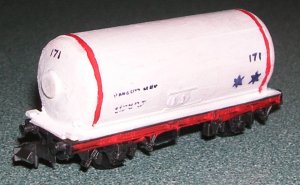
You have to add the sliding valve covers on the sides as Peco have printed rather than moulded them on their model. Peco (and I) also forgot the pressure relief valves on the top. Esso built a fleet of similar four wheeled wagons in the later 1960s to carry butane and propane from their Fawley refinery, however I have not yet found an early photograph so I cannot illustrate the livery.
These tank wagon had a rather long life, converted from vacuum to air brake I believe some were still operating in 2005 and quite possibly later than that. In practice LPG tank wagons built for one oil company often ended up later in life carrying cargo for another (the original logo having been removed).
The prototype bogie LPG tank ran in 1967 and the idea was taken up by Esso and later BP and others. The Graham Farish 100 ton tank wagon can be converted to represent a British built
LPG tanker as shown in the Goods Rolling Stock Design - Rail Tanks
section.
Quite a lot of LPG has been
shifted in ferry tank wagons since the 1960's, many of the tank wagons used
were owned by the German VTG company but a number of ferry-equipped LPG tanks
were built by British Railways in 1962 and leased to a company called Tank
Rentals Ltd (which became part of Traffic Services Limited (TSL) later in the
decade). The British stock is normally painted in the hiring company livery but
they have the leasing company logo displayed. Ferry traffic is more fully
discussed in the section on Freight Operations - Ferry Traffic.
Coming the other way were some bogie LPG tanks of French manufacture, operated in the UK by STS. They were built in the later 1960s but I am not sure when they operated in the UK. They are similar to the British tanks but have a metal sheet boxing in the underframe, as though they had a conventional chassis, which extends out to the full width of the bogies and is about a foot deep.
LPG is generally hauled in `block trains' between major
terminals, with occasional `trip' workings of one or more tanks to outlying
storage or road tanker depots. Only a single tank can be included in a rake if
there is no guard on the train. The four wheeled rail tanks carry 40 tons and the bogie tanks 90 tons, a small depot supplying propane and butane would only require a couple of these tanks perhaps twice a week. The local bottled gas distributor in my area, quite a large operation, has four 40 ton tanks for butane and two 80 ton tanks for propane, a lot goes out in bottles, some is delivered by tanker lorry, most of which are 6 tone payload. A typical domestic central heating tank holds about half a ton of propane, a filling station tank for LPG cars only takes about 6 tons. An industrial user, glass works or similar might have two or three tanks per delivery.
One gas distribution company, Unitank, had six rail-served gas terminals around the country in the early 1980's, most cargo arriving as trip workings under the Speedlink
service. One odd point is that these terminals required a 'reach wagon' so the loco did not need to cross the threshold of the depot (see also Freight Operations - Categories of Goods Train and usage of rolling stock).In the early 1980s, where such a wagon was not stationed at the terminal it was common practice to add a standard BR brake van to the rake to serve this purpose (Richard, a former goods train guard advised that 'lighting the stove was frowned upon!').
The sketch below shows a typical small outlying terminal, the storage
tanks are assumed to be off-stage and connected by underground pipes. Such a
terminal might only handle a single Farish bogie tank conversion or two Peco
fifteen foot wheelbase tanks but doubling this size would be more likely. The
sketch assumes the pipes are buried in the ground, this saves you quite a lot
of wire bending. If you wish to add above ground pipework you would need at
least two 'ten inch' pipes, a 'five inch' pipe and a couple of 'two inch'
pipes. There should also be a red 'two inch' pipe to feed the water sprays in
case of fire on one of the wagons or pipe connections. Flexible hoses for
connecting the wagons can be represented by coiled steel guitar strings, these
should be painted light grey or matt aluminium (the real things are steel
reinforced and known as 'anaconda hoses', they cost a fortune).
Fig
___ Small local LPG terminal
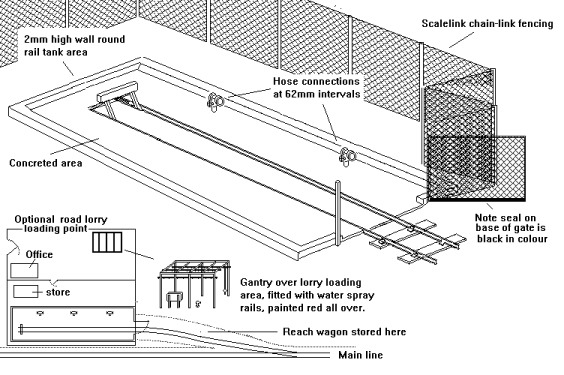
Ammonia
Ammonia tanks are
sometimes mentioned in connection with traffic from gas works, these were
actually conventional tank wagons carrying ammonia dissolved in water
(ammoniacal liquor) rather than compressed ammonia gas (anhydrous ammonia or
NH3). A couple of early ammoniacal liquor tanks have been illustrated in the
section on Rolling Stock Design - Tank Wagons. These would have travelled as
single wagon loads through the system. Anhydrous ammonia is produced in oil
refineries and is shipped, compressed to liquid form, in gas tank wagons. A
major customer for both forms of ammonia (either the gas works type or the
compressed gas) is the fertiliser industry but explosives factories also made
considerable use of this material. I believe the great majority (if not all)
ammonia tanks were private owner vehicles, either owned outright by the firm
using them or leased from wagon hiring firms.
The Farish bogie tank
wagon can be modified to represent the most common design of modern compressed
gas tank wagons and the Ibertren range (currently unavailable) included a bogie
gas tanker which looked very like a type used for ammonia by Fissons the
fertiliser company in the 1980's (see Rolling Stock Design - Tank Wagons). The
modern ammonia gas tanks would normally travel as a block load from the oil
refinery where the gas is made to the marshalling yard but would probably then
be distributed as wagon load traffic.
Liquid Natural Gas
(LNG)
LNG (Liquid Natural Gas, 85% Methane, 10% Ethane and the rest
made up of Butane, Propane & Nitrogen) is shipped in rail wagons, although
these are rare as most is shipped thought the British Gas pipeline network. LNG
tanks have to handle temperatures as low as -160 degrees centigrade and as the
cargo warms up they have to withstand much higher pressures than the LPG tanks.
They are therefore very expensive to build and not very common. LNG tanks only
operate between fairly large terminals and I think they operate as block
trains.
Liquid Oxygen
BOC had an arrangement with
British Steel to supply tankers of oxygen to the steel works when the on-site
oxygen making apparatus was under repair or maintenance. They used tankers
similar to the Graham Farish bogie tank for this work (see Rolling Stock
Design- Tank Wagons for details of the modifications required). I believe the
service involved as few as two tank loads at a time, presumably shifted in
Speedlink as a block load, but these may well have been tagged onto the block
load working to the steel works for final delivery. Oxygen is classed (I
believe) as an explosive and required vans as barrier vehicles. BOC had at
least one VAA van in BOC livery, there is a photograph of this vehicle taken in
1973 on John Turner's excellent website (see App 7 Useful Links).
Fig
___ BOC Barrier Van

Highly Dangerous Chemicals
There are only two chemicals
that were considered dangerous enough to warrant a separate entry in the
railways Working Manual For Rail Staff. This provided staff with details on the
properties and effects of both compounds and gave instructions on the
restrictions to be observed for their carriage. The earlier cargo to be treated
in this way was tetraethyllead (UN No. 1649 the most common anti-knock petrol
additive from the later 1950's up to the mid 1980's). This is described as
Extremely poisonous (in italics). The lethal dose is about 12mg per kg of body
weight. The standard instructions warn that Acute or chronic poisoning may
occur if inhaled or absorbed through the skin.
The tanks for Associated
Octel tetraethyllead were also built to be as puncture proof as possible but
they were sometimes conveyed in mixed goods trains. When this was done there
was a restriction on their being marshalled adjacent to wagons conveying steel,
to avoid the dangers of a barrel being punctured by a shifted load. Some of
this stuff was shifted in demountable tanks on ten foot wheelbase chassis,
details will be found in the section on Livery - Tank Wagons.
Hydrocyanic Acid (HCN) is almost certainly the
most dangerous cargo carried by rail, technically the correct name should be
Hydrogen Cyanide (it is a greenish gas). Other names used for this stuff are
prussic acid, formonitrile, aero liquid HCN, and zaclondiscoids. Hydrogen
cyanide is used in producing adiponitrile for nylon, methyl methacrylate,
sodium cyanide, cyanuric chloride, chelating agents, and miscellaneous other
uses, including in the manufacture of insecticides and rodenticides for
fumigating enclosed spaces, ferrocyanides, acrylates, lactic acid,
pharmaceuticals, and specialty chemicals. It is a severe explosion hazard when
exposed to heat or flame, or by chemical reaction with oxidizers. Under certain
conditions, particularly contact with alkaline materials, hydrogen cyanides can
polymerize or decompose explosively. The gas forms explosive mixtures with air
and will react with water, steam, acid, or acid fumes to produce highly toxic
fumes of cyanides. This stuff is very toxic by inhalation, ingestion and
through skin contact. Inhalation, ingestion or skin contact may be fatal (it
can be absorbed through the skin). The TUA four wheeled wagons used for HCN are
owned by ICI (Grangemouth), built in 1970 they resemble the Peco long wheelbase
tank (the wheelbase is correct and the body and chassis are about the right
size) but they have raised ends and sides to protect the tank in case of a
derailment. The raised sides on the chassis are white but I think the ends are
red, there is a section of walkway on the roof and a filling dome on the top
centre. There may be a single access ladder (I am not sure on this), if there
is it is in the centre not at the end as on the usual Peco model. The train
operates as a block load and consists of only five wagons (this is a legal limit set by law, I
believe only 14 of these wagons were built). It has to have two barrier wagons at either end
and a guards van had to be attached so the train crew would not need to get
past the tanks to place detonators on the line. The crew were supplied with a
special emergency medical kit, the antidote has to be taken within about a
minute of exposure. There was once a derailment involving these tanks (in 1975)
however non of the tanks leaked. This may be because the tanks themselves are
built to the same specification as those used for compressed gas, they even
bear the orange horizontal stripe. I do not know the details of this particular
traffic but I was under the impression that hydrogen cyanide is shipped
dissolved in ethanol, in which case the tank would not need to be a pressure
vessel, but I could be wrong and these tanks may indeed be carrying a
compressed gas. According to the Historical Model Railway Society photo
collection catalogue these wagons carried Lloyds & Scottish logo on the
tank sides in 1972 (they have a photo of same in the collection) but by the mid
1980's they were white with the orange stripe and the ICI logo to the right
hand end. There was also rather a lot of writing on the tank but I do not have
a decent photo and my notes are scanty so I cannot attempt a sketch.
Changes since the 1970's
There have been three
significant changes to the movement of dangerous goods by rail since the later
1970's, all of these have reduced chemical traffic carried by rail.
The
Health & Safety Executive decided, I think in the 1980's, that companies
should only store small amounts of dangerous chemicals on their premises. This
change in the law favoured frequent movements of smaller quantities and this
encouraged a change to road haulage rather than rail transport. As a result
there has been a shift from relatively safe rail transportation of dangerous
goods in bulk to moving them in small but still deadly quantities on the much
less well regulated roads.
On the continent the movement of dangerous
goods by rail is commonplace but dangerous goods are not allowed through the
channel tunnel. The regular rail traffic in acids and other dangerous chemicals
which used to cross the channel on the train ferries has ceased. These
chemicals are now moved on road tank wagons which cross over on the ro-ro
ferries and trundle on over crowded roads through densely populated areas
crushing the Victorian sewers beneath.
The third major change has been
the government sponsored shift away from manufacturing industry toward a
'service' economy. This naturally resulted in a reduced demand for chemicals,
for example steel works required large quantities of acids to remove the scale
on the newly made steel. The closure of so many of the former British Steel
works has also meant a reduction in the transport of bulk liquid oxygen.
^
Go to top of page
International Good Guys ~ Making the world a
better place since 1971 ~ Site maintained by

All material Copyright © Mike
Smith 2003 unless otherwise credited









